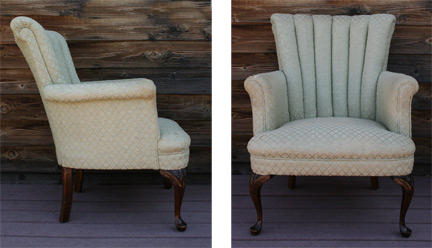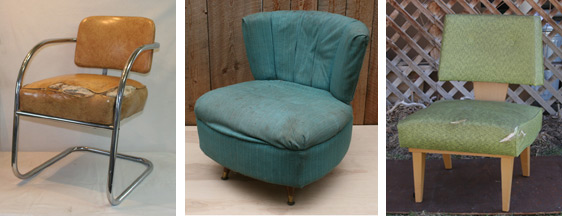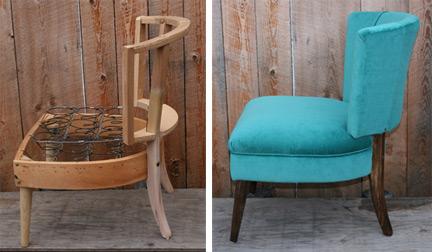Are you contemplating a serious (or simple) re-upholstery endeavor, but are not sure where to start or what lies beneath that outdated or worn cover fabric? Questions from many aspiring students of upholstery about what to expect in undertaking an upholstery project have inspired me to create this simple snapshot: 10 Steps in the Upholstery Process. This post looks at the first step of determining the real potential of your project.
Step 1 – Evaluation
Upholstery restoration is often a major time investment. The most important thing is to first ask yourself how you feel about this particular piece of furniture. Do you love it for it’s shape? Is it super-comfortable? Just the right size? Did it belong to your grandparents? Or maybe you just like the idea of saving a solid old piece from the landfill? Once you have assured yourself that the work will be worth your time, you’re ready to assess the condition of your project.

Restoration of furniture that evokes happy memories is always worth the time & effort
No matter how ripped and soiled the upholstery fabric & padding becomes, if it has solid ‘bones’ (a sturdy frame) it’s usually restorable. Loose screws or bolts and separated glue joints can most often be repaired. Even cracked wood can be glued or replaced, depending on the part it plays in the structural support. Moving parts such as rocker or swivel mechanisms are replaceable as well.

How do you know whether your chair project is worth your time investment to re-upholster?
At this stage you want to determine the potential strength (or weakness) of the underlying frame without removing the upholstery, if possible:
1. The first test is to grasp two opposing parts of the chair, like an arm or a leg with one hand and the back with the other hand, and try to wiggle back and forth in a couple of different directions. If there is any movement, then it probably will need tightening or repair.
2. Next, you may want to remove the ‘dust cloth’ – the light weight fabric tacked to the underside of the seat – to check the condition from below. Here you may see that the springs need to be re-tied or webbing replaced. If the structure includes any composite-wood substitutes such as particle board or chip board, then major restoration is probably not worth your time, as this material is not repairable and tends to literally fall apart with wear.
3. If there is exposed decorative wood or metal, does it need cleaning? refinishing? Take note of any improvements you would like to see to these parts in your finished project, and plan accordingly.

On the left, the old upholstery stripped down to the chair’s wooden frame & springs. On the right, the same frame after re-upholstery
If you have obvious underlying wood or metal damage and aren’t sure what to do, I suggest taking it to a professional to get your frame evaluated. Often the extent of necessary repairs is not apparent until you strip away the soft layers. A furniture repair shop may ask to remove parts of the upholstery in order to provide you with an accurate assessment, or you can do this yourself if you’re the adventurous type. Whether you do this yourself or take it to a professional, be sure to label the old upholstery parts before removing them and keep the pieces intact for patterning in Step 6 – Reconstruction, and take lots of photos & notes!
Next: Step 2 – Measuring
Join NaturalUpholstery.com’s mailing list to receive our monthly newsletter with reupholstery tips, creative inspiration, and resources for using natural, non-toxic materials for upholstery.
Thanks for reminding me to check if the furniture is still in a good condition prior to reupholstery. I just recently bought a couch from a flea market and I wanted to update its look so it will fit in the motif of my living room. Although, I don’t think I have the time to do it myself so it might be best to have it done by a professional instead.